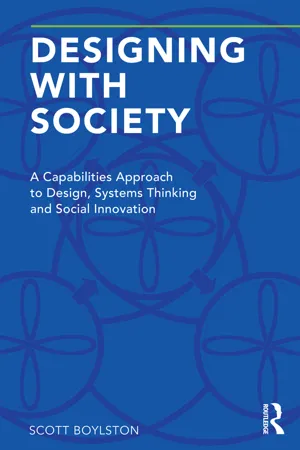
Designing with Society
A Capabilities Approach to Design, Systems Thinking and Social Innovation
- 240 pages
- English
- ePUB (mobile friendly)
- Available on iOS & Android
Designing with Society
A Capabilities Approach to Design, Systems Thinking and Social Innovation
About this book
This book explores an emerging design culture that rigorously applies systems thinking to the practice of design as a form of facilitating change on an increasingly crowded planet. Designers conversant in topics such as living systems, cultural competence, social justice, and power asymmetries can contribute their creative skills to the world of social innovation to help address the complex social challenges of the 21st century.
By establishing a foundation built on the capabilities approach to human development, designers have an opportunity to transcend previous disciplinary constraints, and redefine our understanding of design agency. With an emphasis on developing an adaptability to dynamic situations, the cultivation of diversity, and an insistence on human dignity, this book weaves together theories and practices from diverse fields of thought and action to provide designers with a concrete yet flexible set of actionable design principles. And, with the aim of equipping designers with the ability to drive long-term, sustainable change, it proposes a new set of design competences that emphasize a deeper mindfulness of our interdependence; with each other, and with our life-giving natural systems. It's a call to action to use design and design thinking as a tool to transform our collective worldviews toward an appreciation for what we all hold in common; a hope and a belief that our future is a place where all of humankind will flourish.
Frequently asked questions
- Essential is ideal for learners and professionals who enjoy exploring a wide range of subjects. Access the Essential Library with 800,000+ trusted titles and best-sellers across business, personal growth, and the humanities. Includes unlimited reading time and Standard Read Aloud voice.
- Complete: Perfect for advanced learners and researchers needing full, unrestricted access. Unlock 1.4M+ books across hundreds of subjects, including academic and specialized titles. The Complete Plan also includes advanced features like Premium Read Aloud and Research Assistant.
Please note we cannot support devices running on iOS 13 and Android 7 or earlier. Learn more about using the app.
Information
NOTES
INTRODUCTION
SECTION ONE INTRODUCTION
CHAPTER ONE
Table of contents
- Cover
- Half Title
- Copyright Page
- Title Page
- Dedication
- Introduction
- Section One: Interdependence, and Why Social Innovation Matters
- Section Two: Designing with Mindfulness, Balance, and a Commitment to Justice
- Section Three: An Emerging Design Agency in Social Innovation
- Appendix
- Notes
- Index